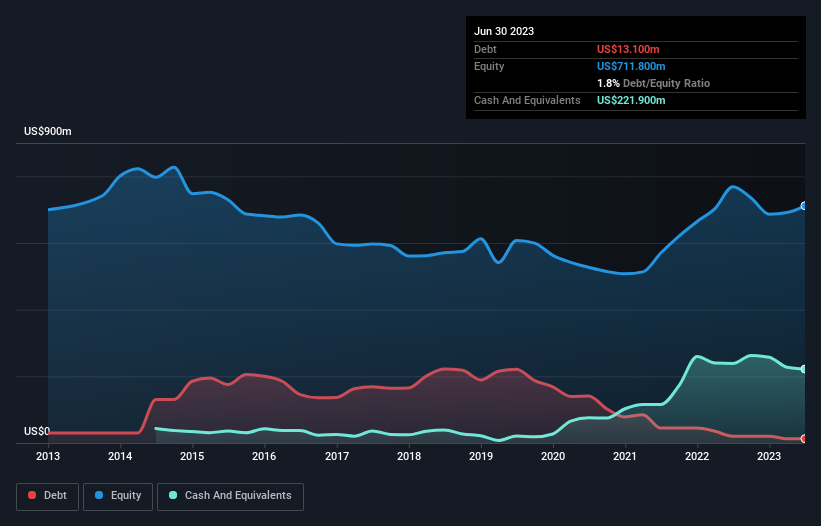- United States
- /
- Metals and Mining
- /
- NYSE:MTUS
Here's Why TimkenSteel (NYSE:TMST) Can Manage Its Debt Responsibly
Some say volatility, rather than debt, is the best way to think about risk as an investor, but Warren Buffett famously said that 'Volatility is far from synonymous with risk.' So it seems the smart money knows that debt - which is usually involved in bankruptcies - is a very important factor, when you assess how risky a company is. As with many other companies TimkenSteel Corporation (NYSE:TMST) makes use of debt. But should shareholders be worried about its use of debt?
When Is Debt Dangerous?
Debt assists a business until the business has trouble paying it off, either with new capital or with free cash flow. If things get really bad, the lenders can take control of the business. However, a more frequent (but still costly) occurrence is where a company must issue shares at bargain-basement prices, permanently diluting shareholders, just to shore up its balance sheet. By replacing dilution, though, debt can be an extremely good tool for businesses that need capital to invest in growth at high rates of return. When we examine debt levels, we first consider both cash and debt levels, together.
View our latest analysis for TimkenSteel
How Much Debt Does TimkenSteel Carry?
You can click the graphic below for the historical numbers, but it shows that TimkenSteel had US$13.1m of debt in June 2023, down from US$20.4m, one year before. However, it does have US$221.9m in cash offsetting this, leading to net cash of US$208.8m.

How Healthy Is TimkenSteel's Balance Sheet?
We can see from the most recent balance sheet that TimkenSteel had liabilities of US$219.8m falling due within a year, and liabilities of US$216.9m due beyond that. Offsetting these obligations, it had cash of US$221.9m as well as receivables valued at US$133.3m due within 12 months. So its liabilities outweigh the sum of its cash and (near-term) receivables by US$81.5m.
Of course, TimkenSteel has a market capitalization of US$910.4m, so these liabilities are probably manageable. Having said that, it's clear that we should continue to monitor its balance sheet, lest it change for the worse. While it does have liabilities worth noting, TimkenSteel also has more cash than debt, so we're pretty confident it can manage its debt safely.
The modesty of its debt load may become crucial for TimkenSteel if management cannot prevent a repeat of the 79% cut to EBIT over the last year. When a company sees its earnings tank, it can sometimes find its relationships with its lenders turn sour. There's no doubt that we learn most about debt from the balance sheet. But ultimately the future profitability of the business will decide if TimkenSteel can strengthen its balance sheet over time. So if you're focused on the future you can check out this free report showing analyst profit forecasts.
Finally, a business needs free cash flow to pay off debt; accounting profits just don't cut it. While TimkenSteel has net cash on its balance sheet, it's still worth taking a look at its ability to convert earnings before interest and tax (EBIT) to free cash flow, to help us understand how quickly it is building (or eroding) that cash balance. Over the last three years, TimkenSteel recorded free cash flow worth a fulsome 95% of its EBIT, which is stronger than we'd usually expect. That positions it well to pay down debt if desirable to do so.
Summing Up
We could understand if investors are concerned about TimkenSteel's liabilities, but we can be reassured by the fact it has has net cash of US$208.8m. And it impressed us with free cash flow of US$58m, being 95% of its EBIT. So we don't have any problem with TimkenSteel's use of debt. Even though TimkenSteel lost money on the bottom line, its positive EBIT suggests the business itself has potential. So you might want to check out how earnings have been trending over the last few years.
At the end of the day, it's often better to focus on companies that are free from net debt. You can access our special list of such companies (all with a track record of profit growth). It's free.
New: Manage All Your Stock Portfolios in One Place
We've created the ultimate portfolio companion for stock investors, and it's free.
• Connect an unlimited number of Portfolios and see your total in one currency
• Be alerted to new Warning Signs or Risks via email or mobile
• Track the Fair Value of your stocks
Have feedback on this article? Concerned about the content? Get in touch with us directly. Alternatively, email editorial-team (at) simplywallst.com.
This article by Simply Wall St is general in nature. We provide commentary based on historical data and analyst forecasts only using an unbiased methodology and our articles are not intended to be financial advice. It does not constitute a recommendation to buy or sell any stock, and does not take account of your objectives, or your financial situation. We aim to bring you long-term focused analysis driven by fundamental data. Note that our analysis may not factor in the latest price-sensitive company announcements or qualitative material. Simply Wall St has no position in any stocks mentioned.
About NYSE:MTUS
Metallus
Manufactures and sells alloy steel, and carbon and micro-alloy steel products in the United States and internationally.
Good value with reasonable growth potential.
Similar Companies
Market Insights
Community Narratives



